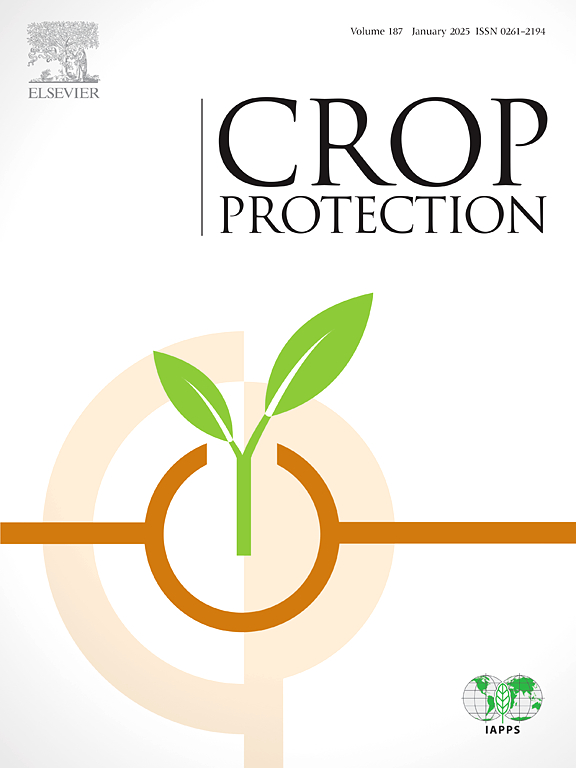Survey of plant viruses in Wisconsin iris production demonstrates widespread prevalence of Potyvirus iriseverum
IF 2.5
2区 农林科学
Q1 AGRONOMY
引用次数: 0
Abstract
Field surveys were conducted in Wisconsin in 2021 and 2022 to assess the prevalence of Potyvirus iriseverum (previously Iris severe mosaic virus, ISMV) in field grown irises and wild populations in surrounding areas. A total of 460 samples were collected from 19 sites in 10 Wisconsin counties. The plants sampled included field-grown Iris x germanica (bearded iris) and Iris sibirica (Siberian iris), and naturally occurring Iris versicolor (blue flag). The survey revealed notable differences in ISMV occurrence among iris species. Cultivated bearded iris exhibited a high incidence rate of 81 % in 2021 and 73 % in 2022. Interestingly, 74 % of bearded iris without visible symptoms tested positive for ISMV by DAS-ELISA. In contrast, other species, such as the native blue flag, found in neighboring wetlands, and Siberian iris, exclusively tested negative for the virus. This survey highlights the high prevalence of ISMV in field-grown bearded iris in Wisconsin. In addition, it indicates that diagnostics for ISMV should not rely on detection based solely on visual symptoms.
对威斯康星州鸢尾花生产中植物病毒的调查表明鸢尾花Potyvirus iriseverum广泛流行
于2021年和2022年在威斯康星州进行了实地调查,以评估鸢尾Potyvirus iriseverum(以前称为鸢尾严重花叶病毒,ISMV)在田间种植的鸢尾和周围地区野生种群中的流行情况。从威斯康星州10个县的19个地点共收集了460份样本。取样的植物包括田间种植的德国鸢尾(大胡子鸢尾)和西伯利亚鸢尾(西伯利亚鸢尾),以及自然生长的彩鸢尾(蓝旗)。调查结果显示,鸢尾品种间ISMV发生率存在显著差异。栽培的胡须鸢尾在2021年和2022年的发病率分别为81%和73%。有趣的是,通过DAS-ELISA, 74%没有明显症状的大胡子虹膜检测出ISMV阳性。相比之下,其他物种,如在邻近湿地发现的本地蓝旗和西伯利亚虹膜,对该病毒的检测均为阴性。这项调查突出了ISMV在威斯康星州田间种植的胡须鸢尾花中的高流行率。此外,它还表明,ISMV的诊断不应仅仅依赖于基于视觉症状的检测。
本文章由计算机程序翻译,如有差异,请以英文原文为准。
求助全文
约1分钟内获得全文
求助全文
来源期刊

Crop Protection
农林科学-农艺学
CiteScore
6.10
自引率
3.60%
发文量
200
审稿时长
29 days
期刊介绍:
The Editors of Crop Protection especially welcome papers describing an interdisciplinary approach showing how different control strategies can be integrated into practical pest management programs, covering high and low input agricultural systems worldwide. Crop Protection particularly emphasizes the practical aspects of control in the field and for protected crops, and includes work which may lead in the near future to more effective control. The journal does not duplicate the many existing excellent biological science journals, which deal mainly with the more fundamental aspects of plant pathology, applied zoology and weed science. Crop Protection covers all practical aspects of pest, disease and weed control, including the following topics:
-Abiotic damage-
Agronomic control methods-
Assessment of pest and disease damage-
Molecular methods for the detection and assessment of pests and diseases-
Biological control-
Biorational pesticides-
Control of animal pests of world crops-
Control of diseases of crop plants caused by microorganisms-
Control of weeds and integrated management-
Economic considerations-
Effects of plant growth regulators-
Environmental benefits of reduced pesticide use-
Environmental effects of pesticides-
Epidemiology of pests and diseases in relation to control-
GM Crops, and genetic engineering applications-
Importance and control of postharvest crop losses-
Integrated control-
Interrelationships and compatibility among different control strategies-
Invasive species as they relate to implications for crop protection-
Pesticide application methods-
Pest management-
Phytobiomes for pest and disease control-
Resistance management-
Sampling and monitoring schemes for diseases, nematodes, pests and weeds.
 求助内容:
求助内容: 应助结果提醒方式:
应助结果提醒方式:


